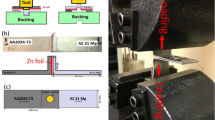Abstract
The modified friction stir clinching (MFSC) of 5083 aluminum alloy to brass using pure Zn interlayer has been explored and elucidated for the first time. By that, the influence of the Zn interlayer thickness on the microstructure and the mechanical properties of the 5083/brass joint was investigated. The attained data have revealed that the intermetallic compound (IMC) layer thickness was mainly influenced by the Zn interlayer. The use of the Zn interlayer restrained the creation of brittle Al–Cu IMCs such as Al4Cu9 during the MFSC process and, in return, softer phases such as Cu4Zn, CuZn5, and CuZn were formed. It was also found that with increasing the thickness of the Zn interlayer from 50 to 100 µm, the thickness of the brazed zone increased and the tensile/shear strength of the spot welds significantly improved from 5250 to 8490 N (approximately 60% increment over the welded sample with 50-µm-thick Zn) which can be ascribed to supreme bonding and homogeneous brazing zone at the interface.






Similar content being viewed by others
References
Gao P, Zhang Y, Mehta KP. Metallurgical and mechanical properties of Al–Cu joint by friction stir spot welding and modified friction stir clinching. Met Mater Int. 2020. https://doi.org/10.1007/s12540-020-00759-w.
Regensburg A, Petzoldt F, Benss T, Bergmann JP. Liquid interlayer formation during friction stir spot welding of aluminum/copper. Weld World. 2019;63:117–25.
Muhammad NA, Wu CS, Tian W. Effect of ultrasonic vibration on the intermetallic compound layer formation in Al/Cu friction stir weld joints. J Alloy Compd. 2019;758:512–22.
Shankar S, Vilaça P, Dash P, Chattopadhyaya S, Hloch S. Joint strength evaluation of friction stir welded Al–Cu dissimilar alloys. Measurement. 2019;146:892–902.
Li WY, Chu Q, Yang XW, Shen JJ, Vairis A, Wang WB. Microstructure and morphology evolution of probeless friction stir spot welded joints of aluminum alloy. J Mater Process Technol. 2018;252:69–80.
Dai X, Zhang H, Wang B, Ji A, Liu J, Feng J. Improving weld strength of arc-assisted ultrasonic seam welded Mg/Al joint with Sn interlayer. Mater Des. 2016;98:262–71.
Ni Z, Zhao H, Mi P, Ye F. Microstructure and mechanical performances of ultrasonic spot welded Al/Cu joints with Al 2219 alloy particle interlayer. Mater Des. 2016;92:779–86.
Esmaeili A, Rajani HRZ, Sharbati M, Givi MKB, Shamanian M. The role of rotation speed on intermetallic compounds formation and mechanical behavior of friction stir welded brass/aluminum 1050 couple. Intermetallics. 2011;19:1711–9.
Elsa M, Khorram A, Ojo OO, Paidar M. Effect of bonding pressure on microstructure and mechanical properties of aluminum/copper diffusion-bonded joint. Sādhanā. 2019;44:126.
Safarzadeh A, Paidar M, Youzbashi-zade H. A study on the effects bonding temperature and holding time on mechanical and metallurgical properties of Al–Cu dissimilar joining by DFW. Trans Indian Inst Met. 2017;70:125–31.
Shamsipur A, Anvari A, Keyvani A. Improvement of microstructure and corrosion properties of friction stir welded AA5754 by adding Zn interlayer. Int J Miner Metall Mater. 2018;25:967–73.
Balasundaram R, Patel VK, Bhole SD, Chen DL. Effect of zinc interlayer on ultrasonic spot welded aluminum-to-copper joints. Mater Sci Eng A. 2014;607:277–86.
Huang G, Feng X, Shen Y, Zheng Q, Zhao P. Friction stir brazing of 6061 aluminum alloy and H62 brass: evaluation of microstructure, mechanical and fracture behavior. Mater Des. 2016;99:403–11.
Zhou X, Chen Y, Li S, Huang Y, Hao K, Peng P. Friction stir spot welding-brazing of Al and hot-dip aluminized Ti alloy with Zn interlayer. Metals. 2018;8:922.
Paidar M, Tahani K, Vignesh RV, Ojo OO, Ezatpour HR, Moharrami A. Modified friction stir clinching of 2024–T3 to 6061–T6 aluminium alloy: effect of dwell time and precipitation-hardening heat treatment. Mater Sci Eng A. 2020;791:139734.
Mehta KP, Patel R, Vyas H, Memon S, Vilaça P. Repairing of exit-hole in dissimilar Al–Mg friction stir welding: process and microstructural pattern. Manuf Lett. 2020;23:67–70.
Sahu PK, Pal S, Shi Q. Effect of solid solution phase constitution on dissimilar Al/Cu FSW using Zn as an alloying element at the joint interface. SN Appl Sci. 2019;1:1659. https://doi.org/10.1007/s42452-019-1708-5.
Ji S, Niu S, Liu J, Meng X. Friction stir lap welding of Al to Mg assisted by ultrasound and a Zn interlayer. J Mater Process Technol. 2019;267:141–51.
Zhang G, Zhang L, Kang C, Zhang J. Development of friction stir spot brazing (FSSB). Mater Des. 2016;94:502–14.
Mehta KP, Badheka VJ. A review on dissimilar friction stir welding of copper to aluminum: process, properties, and variants. Mater Manuf Process. 2016;31:233–54.
Mehta KP, Badheka VJ. Hybrid approaches of assisted heating and cooling for friction stir welding of copper to aluminum joints. J Mater Process Technol. 2017;239:336–45.
Patel NP, Parlikar P, Dhari RS, Mehta K, Pandya M. Numerical modelling on cooling assisted friction stir welding of dissimilar Al–Cu joint. J Manuf Process. 2019;47:98–109.
Boucherit A, Avettand-Fènoël MN, Taillard R. Effect of a Zn interlayer on dissimilar FSSW of Al and Cu. Mater Des. 2017;124:87–99.
Author information
Authors and Affiliations
Corresponding authors
Ethics declarations
Conflict of interest
The authors declare that they have no conflict of interest.
Ethics approval
We confirm that this work is original and has not been published elsewhere, nor it is currently under consideration for publication elsewhere. All the authors have approved the manuscript and have agreed with its submission to your journal.
Additional information
Publisher's Note
Springer Nature remains neutral with regard to jurisdictional claims in published maps and institutional affiliations.
Appendix 1
Appendix 1
Rights and permissions
About this article
Cite this article
Li, J., Tang, F. & Paidar, M. Modified friction stir clinching-brazing of brass to AA5083 aluminum alloy using Zn interlayer. Archiv.Civ.Mech.Eng 21, 13 (2021). https://doi.org/10.1007/s43452-020-00162-7
Received:
Revised:
Accepted:
Published:
DOI: https://doi.org/10.1007/s43452-020-00162-7






